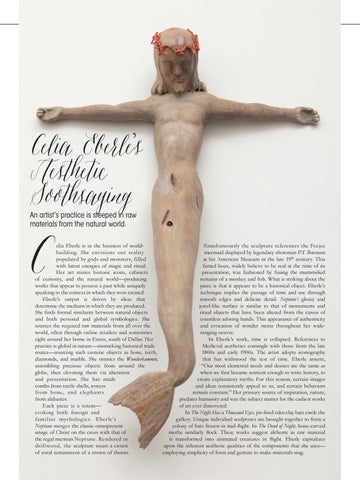Celia Eberle’s Aesthetic Soothsaying
An artist’s practice is steeped in raw materials from the natural world.
C
elia Eberle is in the business of worldSimultaneously the sculpture references the Feejee building. She envisions our reality mermaid displayed by legendary showman P.T. Barnum populated by gods and monsters, filled at his American Museum in the late 19th century. This with latent energies of magic and ritual. famed hoax, widely believe to be real at the time of its Her art mines historic icons, cabinets presentation, was fashioned by fusing the mummified of curiosity, and the natural world—producing remains of a monkey and fish. What is striking about the works that appear to possess a past while uniquely piece is that it appears to be a historical object. Eberle’s speaking to the context in which they were created. technique implies the passage of time and use through Eberle’s output is driven by ideas that smooth edges and delicate detail. Neptune’s glossy and determine the medium in which they are produced. jewel-like surface is similar to that of monuments and She finds formal similarity between natural objects ritual objects that have been altered from the caress of and both personal and global symbologies. She countless adoring hands. This appearance of authenticity sources the required raw materials from all over the and evocation of wonder stems throughout her wideworld, often through online retailers and sometimes ranging oeuvre. right around her home in Ennis, south of Dallas. Her In Eberle’s work, time is collapsed. References to practice is global in nature—mimicking historical trade Medieval aesthetics comingle with those from the late routes—sourcing such esoteric objects as bone, teeth, 1800s and early 1900s. The artist adopts iconography diamonds, and marble. She mimics the Wunderkammer, that has withstood the test of time. Eberle asserts, assembling precious objects from around the “Our most elemental needs and desires are the same as globe, then elevating them via alteration when we first became sentient enough to write history, to and presentation. She has made create explanatory myths. For this reason, certain images combs from turtle shells, towers and ideas consistently appeal to us, and certain behaviors from bone, and elephants remain constant.” Her primary source of inspiration, nature, from alabaster. predates humanity and was the subject matter for the earliest works Each piece is a totem— of art ever discovered. evoking both foreign and In The Night Has a Thousand Eyes, pit-fired raku clay bats circle the fam i l iar my t holog ies. Eberle’s gallery. Unique individual sculptures are brought together to form a Neptune merges the classic omnipresent colony of bats frozen in mid-flight. In The Dead of Night, bone-carved moths similarly flock. These works suggest alchemy as raw material image of Christ on the cross with that of is transformed into animated creatures in flight. Eberle capitalizes the regal merman Neptune. Rendered in upon the inherent aesthetic qualities of the components that she uses— driftwood, the sculpture wears a crown of coral reminiscent of a crown of thorns. employing simplicity of form and gesture to make materials sing.
62
PATRONMAGAZINE.COM
